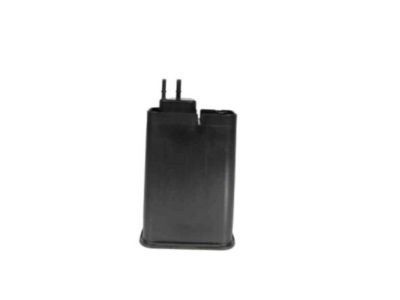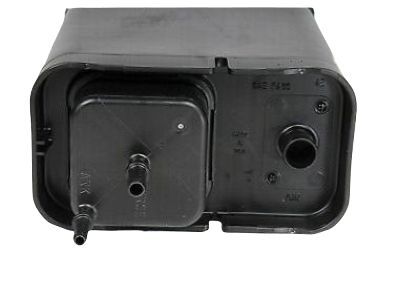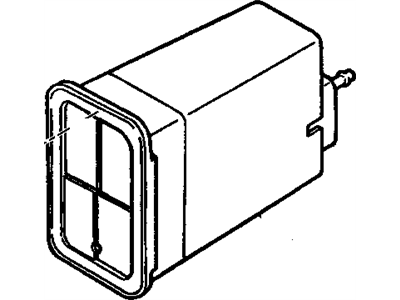Your vehicle deserves only genuine OEM GM parts and accessories. To ensure reliability, purchase GM part # 17113330 Canister Asm,Evap Emission. It is sometimes referred to as Cadillac Vapor Canister. Our GM parts and accessories are expedited directly from authorized GM dealers strategically located all across the U.S. and are backed by the manufacturer's 12 month, 12,000 mile warranty. OEM GM parts are the best for restoring your vehicle to factory condition performance. This part fits specific Cadillac Escalade models.
Affordable, reliable and built to last, GM part # 17113330 Canister Asm,Evap Emission stands out as the smart option. GMPartsGiant.com is your prime online source with the biggest and best selection of genuine GM parts and accessories at giant discounted prices. We have the OEM GM parts and accessories you need at the wholesale prices. GMPartsGiant.com has you covered no matter what type of GM vehicle you drive. For detailed Cadillac parts information, click here.
×

My Garage
My Account
My Cart
Make sure this part fits your vehicle
Cadillac 17113330 Canister Asm,Evap Emission
1999-2000 Cadillac Escalade

- Part DescriptionCANISTER, Fuel Tank Evaporator/Purge Control
- Replaces17113310
- ManufacturerGeneral Motors
$158.19 MSRP: $287.62 1
You Save: $129.43 (46%)
Ships in 1-2 Business Days
Product Specifications
Brand Genuine Cadillac Manufacturer Part Number 17113330 Part Description CANISTER, Fuel Tank Evaporator/Purge Control Other Names Vapor Canister Item Dimensions 13.9 x 12.2 x 7.0 inches Item Weight 3.80 Pounds Condition New Fitment Type Direct Replacement Replaces 17113310 Manufacturer General Motors SKU 17113330 Warranty This genuine GM part is guaranteed by GM's factory warranty. Shipping & Return Shipping Policy Return Policy Warning: California’s Proposition 65Vehicle Fitment
Year Make Model Engine Important vehicle option details 1999-2000 Cadillac Escalade 8 Cyl 5.7L 1 TON CREW CAB, 1/2 TON, 4 DOOR 1/2 TON, CLASSIC 4 DOOR 1/2 TON, CREW CAB 1 TON, EXTENDED CAB 1 TON, EXTENDED CAB 6'6" BOX 1/2 TON, EXTENDED CAB 6'6" BOX 3/4 TON, EXTENDED CAB 8' BOX 3/4 TON, K2500 CREW CAB, K3500 CAB CHASSIS 135.5, K3500 CAB CHASSIS 159.9, REGULAR CAB 1 TON, REGULAR CAB 3/4 TON, YUKON/DENALI/ESCALADE
Customer Questions & Answers
- Q:I am wonder if this is complete and correct part for my vehicle. Posted by GMPartsGiant Specialist
- A:You can Select Your Vehicle to check if 17113330 fits your vehicle.Posted by GMPartsGiant Specialist
- Q:What is the role of the fuel evaporative emissions control (EVAP) system,Purge Valve,Fuel Pressure Sensor and Canister for Chevrolet C1500 and K1500? Posted by Customer
- A:The fuel evaporative emissions control (EVAP) system plays a crucial role in managing fuel vapors, absorbing them from the fuel tank and subsequently releasing them into the engine's intake system to mix with incoming air/fuel mixture. This system comprises key components, including the canister filled with activated charcoal for vapor absorption, the purge valve, the vent valve, the fuel tank pressure sensor, the fuel tank itself, and the vapor and purge lines, although the components may vary slightly across different years and applications. Fuel tank vapor, directed through a check valve, enters the charcoal canister via the vapor hose, where the activated charcoal stores the vapors. When specific conditions are met (e.g., engine running, reaching a preset temperature), the ECM/PCM opens both the purge valve and vent valve. Consequently, fuel vapors from the canister are drawn through the purge hose by intake manifold vacuum into the intake manifold and combustion chamber, where they are consumed during normal engine operation. The ECM/PCM controls the vapor flow rate from the canister to the intake manifold by modulating the EVAP purge valve control solenoid's duty cycle. In cold conditions and during a hot start time delay, the ECM/PCM keeps the solenoid de-energized. Once the engine warms up to the correct operating temperature, the ECM/PCM regulates vapor purging into the intake manifold based on the engine's running conditions. The ECM/PCM cycles the purge valve control solenoid (ON and OFF) approximately 5 to 10 times per second, adjusting the flow rate by varying the solenoid's energization time. OBD-II models (1996 through 2000) perform a self-diagnostic check during cold engine startup, wherein the PCM opens the EVAP canister purge valve and closes the vent valve, creating a vacuum in the entire EVAP system. Upon reaching the correct vacuum level, the PCM closes the purge valve to seal the system and monitors the fuel tank pressure sensor voltage, setting a diagnostic code if it detects a leak. These models also feature a fuel tank pressure sensor, similar in operation to a MAP sensor, returning a signal voltage to the PCM corresponding to the air pressure inside the fuel tank, allowing for leak detection. It's important to note that the EVAP system is protected by a federally-mandated warranty of 5 years or 50,000 miles. When troubleshooting the system, start by checking the hoses for damage, disconnection, or misrouting. Repair or replace hoses as needed. For early models without electronic purge controls, inspect the charcoal canister, purge control valve, and vacuum hoses for issues. On late models with electronic purge controls, verify related fuses and wiring integrity for the purge and vent valves. The purge and vent valves are typically closed, with vapor flow initiated by the PCM's solenoid activation. While some limited testing is possible, a scan tool is required for thorough examination. If these initial checks do not identify the problem, consult a dealer service department or qualified repair shop. When replacing components, late model EVAP system hoses are equipped with quick-connect fittings, requiring a twisting motion to loosen the seal before disconnection. The EVAP canister's location varies with the year and application, while removal involves disconnecting hoses and removing the bracket mounting bolt. The purge valve, located on the charcoal canister in early models or on the intake manifold in late models, requires disconnecting the electrical connector, depressing the locking tab to remove the hose, and removing the mounting nuts/bolt. The vent valve on 1996 through 2000 models is mounted on a bracket near the fuel tank, necessitating raising the vehicle, disconnecting the electrical connector, removing the hose, and releasing retainers to remove the vent valve from the bracket. The fuel tank pressure sensor on 1996 through 2000 models is situated on the fuel pump module, requiring fuel tank removal, disconnection of the electrical connector, and release of the retaining clip to remove the sensor from the fuel pump module. Installation for all replaced components follows the reverse of the removal procedure.Posted by GMPartsGiant Specialist
- Q:What are some common issues with the EVAP system for the 2004 Chevrolet Express? Posted by Customer
- A:Common issues with the EVAP system include fuel odors, poor idle, stalling, and driveability problems.Posted by GMPartsGiant Specialist
- See expert answers on similar Vapor Canister
If you have any questions about this product, please don't hesitate to ask us. We will be happy to help you!
Genuine GM Part 17113330, the Right Choice
Why choose GM Parts Giant
- Dedicated Service
Your complete satisfaction is our #1 goal
- Lowest Prices
Best deals on genuine OE parts from dealerships
- Fast Delivery
Orders are processed and delivered promptly










